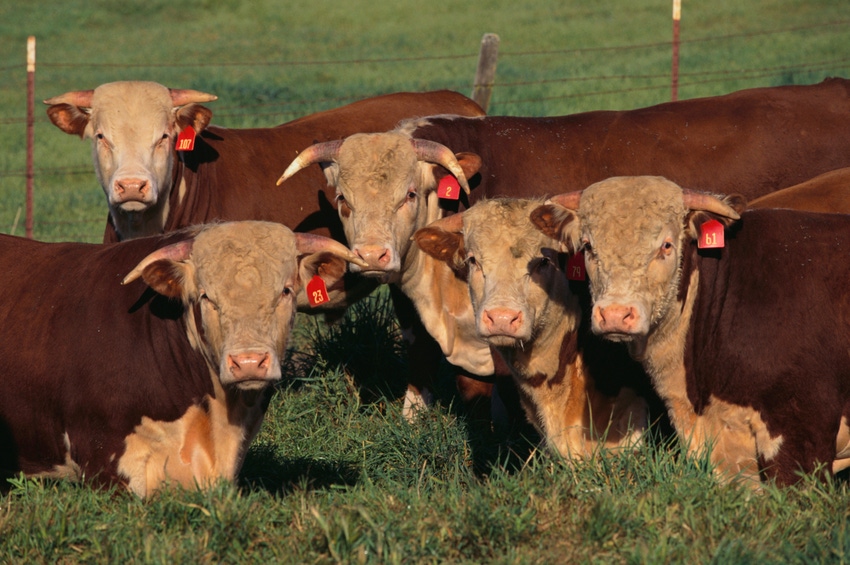Managing trichomoniasis in a cow/calf herd comes down to having a number of strategic management practices in place.
December 4, 2019

Trichomoniasis, or trich, is a sexually transmitted protozoal disease transmitted from cattle bull to female or female to bull, and while clinical signs may not be observed, bulls are the carriers of trichomoniasis and spread it to cows during breeding, according to information from Boehringer Ingelheim.
Infected cows show no outward signs, but reproductive failures such as infertility, low pregnancy rates, abortions and pyometra are indicators of infection, the company added.
“There’s not another disease out there that approaches the economic significance of trichomoniasis for a cow/calf producer,” Dr. John Davidson, a veterinarian with Boehringer Ingelheim, said.
With trich’s ability to cut a calf crop in half, implementing a management protocol is crucial.
“Infected bulls are asymptomatic permanent carriers of this disease,” Davidson said. “A bull’s value can be wiped out in a single service with an infected cow or heifer. Most operations simply cannot tolerate a scenario where a $5,000 bull is used for one or two breeding seasons and is culled due to a trich infection. To avoid lost profits due to reproductive inefficiencies on your operation, I recommend taking a fresh look at the trich prevention and biosecurity protocols you have in place for your herd.”
Discussing the following topics with a local veterinarian can help producers establish an effective trich prevention and management program:
* Bull selection and testing. While bulls of any age are susceptible, older, sexually active bulls are more likely to be infected with trich, Boehringer Ingelheim said. To reduce the likelihood of trich introduction, it is recommended that producers avoid purchasing untested, non-virgin bulls or bringing them into a herd.
Since trichomoniasis is physically unnoticeable in bulls, testing prior to breeding is strongly encouraged.
“Testing bulls for trich before turnout is an absolute must,” Davidson said. “I suggest that large operations in at-risk areas conduct post-breeding testing on bulls. Post-breeding testing, coupled with accurate pasture breeding records, can go a long way in avoiding a trich disaster.”
Prior to testing a bull, sexual rest should be observed for two to three weeks to allow numbers of the organism to increase and improve the chances of detecting a positive bull. Davidson noted that this is also a good time for a veterinarian to perform a breeding soundness exam. The Society for Theriogenology has recently adjusted breeding soundness exam standards to allow for more accurate and potentially more useful results for both veterinarians and producers.
* Vaccine selection. In heifers, the transmission rate of infection was reported to be 95% after a single mating with a three-year-old, trich-infected bull, Boehringer Ingelheim said. Given the ease of transmission and the likelihood of delayed detection, administering appropriate reproductive vaccinations is crucial.
“If a properly vaccinated female is exposed to a trich-infected bull, the likelihood that she calves successfully is increased substantially,” Davidson explained. “Proper vaccinations provide insurance against costly diseases and production losses.”
He recommended that producers choose a vaccine that reduces the shedding of trichomoniasis in addition to a vaccine that can protect against the other leading reproductive diseases. This vaccination plan protects cattle against common diseases known to cause delayed breeding, abortions and smaller calves.
* Vaccination timing. “In trich-prone areas, it’s pretty common to vaccinate cows at pregnancy check,” Davidson said. “However, this may be a little later than ideal to prevent this venereal disease, as peak antibody production typically occurs 30 days after the annual dose is given. For optimal protection, cows should be vaccinated 30 days prior to bulls being turned out.”
He encouraged producers to read and follow the vaccine label closely. Proper administration timing is critical for cattle to receive the intended benefits of a vaccine.
* Recordkeeping. While it can be a daunting task, recordkeeping is key. In a large ranch with multiple breeding pastures, it’s important to know which cows and bulls have been in each pasture. Ear tags and other identification systems are helpful to keep track of the location of bulls and cows, Davidson suggested.
“Managing trichomoniasis comes down to having a number of strategic management practices in place,” he concluded. “Be sure to work with a local veterinarian to tailor trich management protocols to your herd.”
Source: Boehringer Ingelheim, which is solely responsible for the information provided and is wholly owned by the source. Informa Business Media and all its subsidiaries are not responsible for any of the content contained in this information asset.
You May Also Like


.png?width=300&auto=webp&quality=80&disable=upscale)
